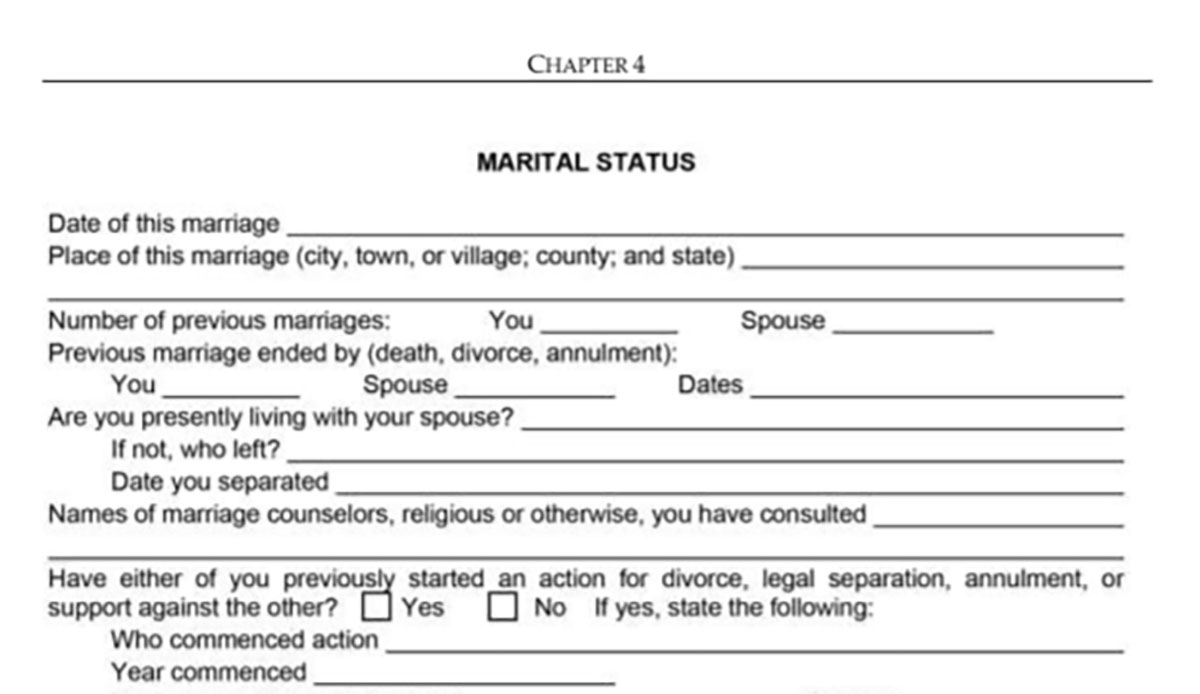
Dec. 7, 2022 – According to
Wisconsin Court System statistics, more than 16,600 divorce cases were opened in Wisconsin in 2021, up from about 15,500 in 2020.
Divorce cases involve complex decisions and processes that can challenge attorneys, especially those new to family law. Knowledge of processes and decision points will allow attorneys of all experience levels to prepare for the complexities of divorce proceedings.
Prepare for that Critical First Interview
For attorneys with a new divorce client, the first meeting is a critical step in providing the best representation for that client. During the interview, attorneys should get to know the client, gather information on the client’s background and marital history, explain divorce procedure and fees, answer the client’s questions, and request relevant documents from the client.
Family Law in Wisconsin: A Forms and Procedures Handbook, Volume 1 (10th ed., 2020) from State Bar of Wisconsin PINNACLE®, offers a solution: the Initial Interview and Fact Gathering checklist, and the Master Information List – two checklists that facilitate a systematic and efficient approach to family law cases.
The checklists in
Family Law in Wisconsin are tools that eliminate unnecessary meetings. For example, the Initial Interview and Fact Gathering checklist offers reminders for each step of the initial interview, including a conflicts check before the first meeting is scheduled, and a set of prompts to get the full story from your client. The checklist also reminds lawyers to discuss general legal concepts with new clients, such as:
no-fault divorce;
legal custody and physical placement;
child support;
spousal maintenance;
property division;
provisions regarding health insurance, uninsured health care-related expenses, and life insurance; and
tax issues.
The purpose of any checklist system is to provide a routine method of gathering and processing information that streamlines data gathering and spares clients undue stress, according to Gregg M. Herman, lead author of
Family Law in Wisconsin: A Forms and Procedures Handbook.
 Shannon Green is communications writer for the State Bar of Wisconsin, Madison. She can be reached by
email or by phone at (608) 250-6135.
Shannon Green is communications writer for the State Bar of Wisconsin, Madison. She can be reached by
email or by phone at (608) 250-6135.
Finding the most efficient way to gather not just necessary information, but also get the necessary documents from the client, saves time and money for both the client and the attorney.
As Herman explains in
Family Law in Wisconsin, “this information is accomplished through a Master Information List (MIL).”
The MIL, Form 4.1 in
Family Law in Wisconsin, can be given as-is to the client, and among other functions, aids clients with their data gathering – saving time and money for the client. (See Figure 1: Form 4.1: Master Information List excerpt below.)
“Once the MIL is complete, the attorney has the necessary information from which to commence the action and complete financial discovery,” Herman notes. The MIL, when complete, cuts down on time spent on letters, phone calls, and client meetings.
The MIL is just one form of many in the two-volume
Family Law in Wisconsin. In Volume 1, for example, chapter 5 contains forms used for commencing a divorce action, such as a summons, a petition for divorce, an affidavit of custody information, a lis pendens, and more.
And chapter 13 in Volume 2 focuses on legal proceedings after a divorce judgment, providing forms for termination of maintenance, adjustment in child support, and others. The forms are available in downloadable format.
One practice tip: Herman recommends that lawyers using the forms check with the relevant county to confirm which forms are used and how they are to be completed. Local circuit court rules are available via the
State Bar’s webpage on Circuit Court Rules on WisBar.org.

Excerpt from Form 4.1: Master Information List,
Family Law in Wisconsin: A Forms and Procedures Handbook, Vol. 1.
More on Referenced PINNACLE Book
Family Law in Wisconsin: A Forms and Procedures Handbook (previously titled
System Book for Family Law) is available as a two-volume set from State Bar of Wisconsin PINNACLE®.
Both volumes are available in print and
online via Books UnBound, the State Bar’s interactive online library, which
recently underwent a significant upgrade. Initially published in 1978, the
Family Law in Wisconsin is now in its 10th edition with an integrated supplement released in 2022.
The two-volume print book costs $270 for members and $337 for nonmembers. For more information, or to place an order, visit the WisBar Marketplace at marketplace.wisbar.org or call the State Bar at (800) 728-7788 or (608) 257-3838.
See additional family law resources
on WisBar Marketplace via this link.
